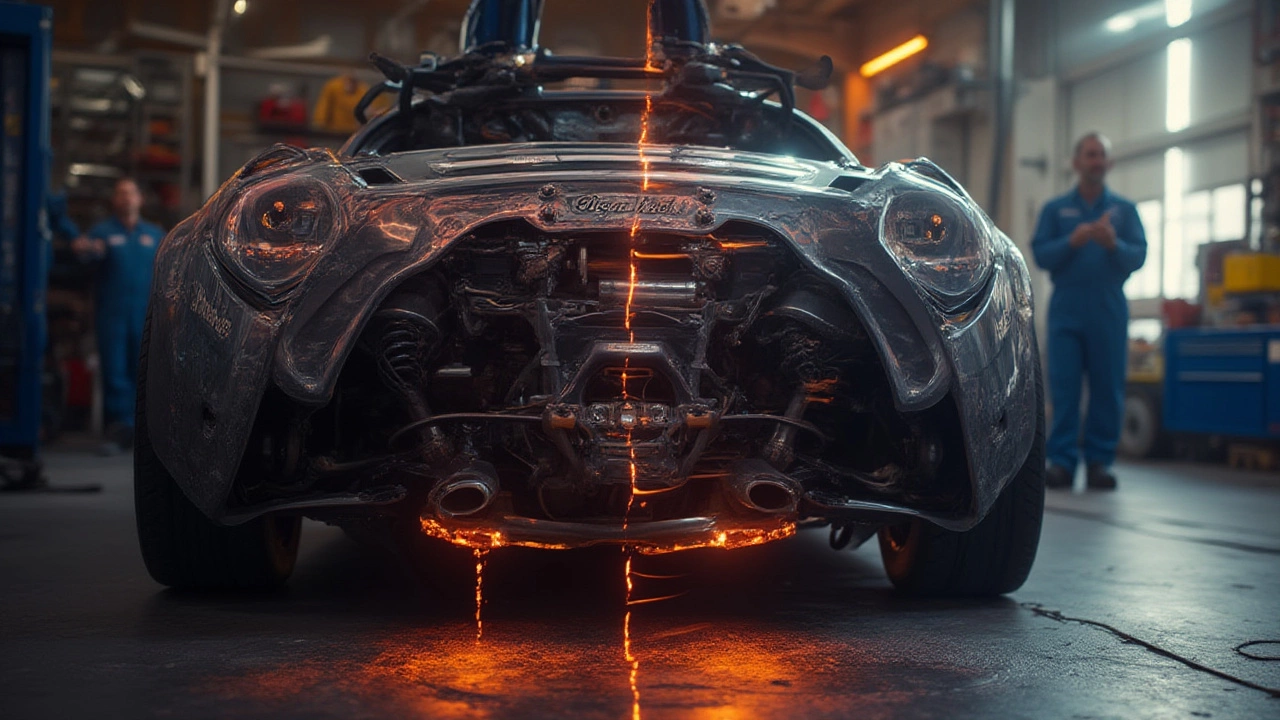MagnaFlow vs Flowmaster: Which Exhaust Brand Reigns Supreme?
 Aug, 1 2025
Aug, 1 2025
If you want a serious row every time petrolheads gather, just bring up the MagnaFlow versus Flowmaster debate. Lines get drawn, loyalties declared. When someone roars past on the M6 with a deep, throaty rumble, someone else will always say, “MagnaFlow, mate!” while another chimes in, “That's the sound of a Flowmaster!” So what's really the difference? Is one brand actually better, or is it all just noise—literally and figuratively?
How Do MagnaFlow and Flowmaster Mufflers Actually Work?
To really understand the rivalry, you have to peek under the car and look at what these mufflers actually do. Both MagnaFlow and Flowmaster are big-name American brands. They’re not just hunks of steel to bolt on—they've spent decades refining how exhaust gases flow, how sound waves bounce, and how your car feels when you put your foot down.
MagnaFlow’s core trick is their straight-through, perforated core design. Picture a laser-straight pipe, stuffed with sound-absorbing packing. Exhaust gases shoot straight through, while the packing dampens harsh noise. There’s a science to the material they use—the stainless steel cores and their dense fiberglass packing aren’t some random wool, but hand-picked for temperature resistance and sound absorption. The result? That deep, mellow growl that’s never annoying but always unmistakable. Your neighbours probably won’t hate you, but they definitely won’t sleep in once you fire up your weekday commute.
Flowmaster takes a totally different approach. They don’t use packing or fiber fill but chambered designs. Instead of letting the gas go straight through, the path zigzags between metal chambers. Exhaust sound waves bounce and reflect inside, cancelling out some frequencies and letting others boom out. The chamber shapes and lengths decide whether you’ll get that classic Flowmaster drone—think muscle car on the drag strip—or a subtler purr. Old school Flowmasters, like the 40 Series, are notorious for their aggressive, raspy tone. And yes, your neighbors might have a word.
The difference in design also changes the way exhaust flows, which can matter for performance. Straight-through mufflers generally support higher horsepower because gases exit more freely, perfect for turbocharged engines or guys who love chasing quarter mile times. Chambered Flowmasters can restrict airflow a bit more, but the sound is so distinctive, some owners will trade off the extra few horses for that signature bark. And honestly, at everyday speeds, the difference in raw numbers is pretty modest unless you’re really pushing high output builds.
If you're choosing between them, think about your car and your goals. MagnaFlow's design favours performance and a smooth sound. Flowmaster is for folks who want that old-school rumble without spending all day at a dyno gym.

Sound, Performance, and Everyday Life: What’s It Like Owning Each Brand?
Ask five drivers and you’ll get ten opinions on which sounds better. But certain facts are clear. MagnaFlow is all about deep, rich tones. On motorways, their mufflers rarely drone. That’s a huge plus if you drive long distances—no more headaches or rattling windows, just a pleasant, confident hum. On the A38, MagnaFlow won’t have you fiddling with the stereo to drown out the muffler.
On the other hand, Flowmaster has its fans for a reason. Their chambered design produces that hard-edged, aggressive rumble people associate with Detroit muscle. The Flowmaster 40 Series in particular is almost a legend for Mustang, Charger, and F-150 owners. It's loud, proud, and instantly recognisable, especially at low RPMs. Just driving around the Tesco car park, passersby will clock the familiar bark and turn their heads.
Performance-wise, neither is a slouch, but each has its niche. MagnaFlow tends to flow a bit better on high-powered or forced-induction engines. If you’re the kind of person who pops the bonnet and tinker with turbo boost or has dreams of dyno charts, MagnaFlow’s often the answer. Their cat-back and axle-back systems often weigh less and use stainless steel, which resists rust—massive if you live somewhere rainy and salty, like, say, England.
Flowmaster makes their systems out of aluminised steel and stainless options too, but the chambered design is a little heavier. It survives British weather just fine if you wash your undercarriage occasionally, but you might see surface rust if you skimp on care. That said, plenty of classic car fans swear by Flowmaster—it’s almost tradition, especially if you’ve got a V8 with proper pipes. The company has even tailored some models for specific vehicles, so you can get a direct bolt-on without hours of DIY frustration under the car in February.
Here’s the thing most dealers won’t say: a lot of people can’t tell the brands apart simply by ear unless they’re up close and personal with the muffler. Both make a range from wild to mild. And with sound clips everywhere online, you can get a pretty good sense before you commit to a new setup. Still, each company has a signature: MagnaFlow’s smooth, Flowmaster’s assertive. Find some YouTube videos of your exact car and muffler combo before you buy. Trust your own ears!
For anyone thinking about the law, both brands offer products that meet MOT and emissions requirements—if you buy the right model for your vehicle and avoid racing-only setups. If it says “street legal,” you're golden. Some of their louder units are technically intended for off-road or racing use in the UK, so double-check before you order if you don’t want a talking-to from your local constabulary.
Here’s a quotable nugget from the automotive bible, Car and Driver:
“If your preference leans toward a mature, refined exhaust note, MagnaFlow is typically the winner. Seeking the full American muscle car experience? Flowmaster’s deep, classic sound remains the benchmark.”
So if you're all about tonal quality and head-turning rumbles, Flowmaster’s the icon. For smoother, modern purrs, MagnaFlow’s tough to beat. Just don’t forget to factor in what your ears—and your neighbours—can actually stand.

Price, Durability, and Real-World Tips for Choosing Your Next Exhaust
The best exhaust isn’t the cheapest or the loudest—it’s the one that fits your life and your car. Here’s what most people don’t talk about when shopping between MagnaFlow and Flowmaster. Price-wise, they’re in the same ballpark if you’re getting into basic axle-back or cat-back kits. You can find MagnaFlow and Flowmaster systems for most popular cars in the UK, from Fiestas that teenagers mod, to the odd American muscle car lovingly imported by a proper enthusiast. Quality versions run from £300 to £750 fit-yourself, or a couple hundred quid extra if you want a garage to bolt it up. Cheap knock-offs abound online, but you’ll notice the difference in sound, fit, and lifespan very quickly if you skimp.
Both brands boast good warranties. MagnaFlow usually offers a limited lifetime warranty on their stainless systems. Flowmaster has warranties that vary by product, but their stainless setups are solid too. That said, stainless steel isn’t magic—everything corrodes eventually, especially in the wet Midlands weather, but you’ll beat out most factory exhausts for lifespan.
If you’re worried about drone—the annoying resonance that turns a motorway cruise into a headache—MagnaFlow is usually the safer pick. Their mufflers are designed to kill the drone at cruising speeds. Flowmaster has some quieter options like the 50 Series Delta Flow for family cars or daily drivers, but the popular chambered types do tend to drone at certain RPMs. People love or hate that about them. Best bet? Find someone locally with your car and ask to hitch a ride. There’s no substitute for actually hearing it at full chat and at a cruise.
Here are some practical tips if you’re torn:
- If you love customising and tuning, MagnaFlow gives the edge in outright performance gains, especially if you mod other parts of your exhaust or engine.
- Want plug-and-play simplicity? Both brands offer direct-fit kits for most popular models, but check the fitment charts online or ask a local shop before buying blindly.
- Dreaming of angry muscle car sounds? Flowmaster owns that territory. Classic American V8? You’ll fit right in at the local meet-up.
- Worried about disturbing your neighbours on the early-morning school run? MagnaFlow’s tone is more civil, but still sounds great.
- Keep in mind build material—stainless steel costs more up front but lasts way longer in wet UK weather.
- Want something in between? Neither company has a monopoly on good sound. You can tune the tone further with different tips, resonators, or even sound-deadening in your boot for daily comfort.
Car culture isn’t about picking winners or losers—it’s about what makes you grin when you pull out of your drive. If you’re after a no-drama, high-performance exhaust that still gets the heads turning, MagnaFlow is a safe bet. For people who live for the rumble, who want their car to announce itself before it even crests the top of the car park, Flowmaster can’t be beaten. Personal taste wins out every time.
So is MagnaFlow better than Flowmaster? It really depends—on what you drive, how you drive, where you drive, and what you want to hear every time you turn the key. If you can, try riding in a car with each brand and then make your choice. The perfect exhaust isn’t just about metal, sound, or even horsepower. It’s about how you feel when your car comes alive.